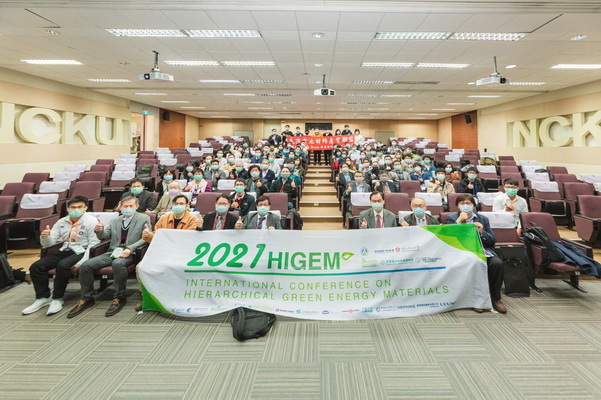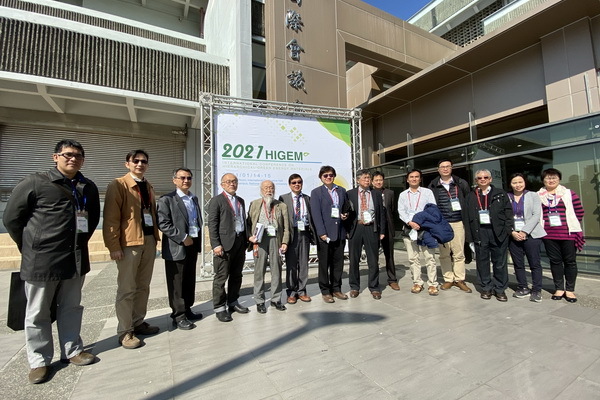2021 International Conference on Hierarchical Green Energy Materials Opens Discussions on Green Energy Materials Technologies
Writing by Hsu Tsu-Yueh. Photo by Chen Hung-Jui.
The National Cheng Kung University (NCKU) Hierarchical Green-Energy Materials (Hi-GEM) Research Center hosted the 2021 International Conference on Hierarchical Green Energy Materials. Experts and scholars from Taiwan, Japan, Australia, Poland, and Canada were invited to share their research results via a video conference. Because the world is facing an energy shortage crisis, the development of green energy and energy storage technologies has become a critical global issue. In this two-day conference, the participants came together to look for directions and to make goals for future development.

2021 International Conference on Hierarchical Green Energy Materials was held at NCKU.
The NCKU Hi-GEM Research Center indicated that green energy is the trend for the future. By combining the power of industry and academia, the Hi-GEM Research Center hopes to expand the global market in order to boost the development of green energy technology industries and economies. International experts and scholars were invited to the two-day 2021 International Conference on Hierarchical Green Energy Materials (2021HIGEM) to engage in discussions focusing on green materials technology and to open up new possibilities for future cooperation.

International experts participated in the conference discussing green energy materials.
This meeting covered novel research directions in the field of green energy materials, including rechargeable batteries, supercapacitors, solar cells, and fuel cells. Many esteemed international scholars attended the conference, including Professor Takeshi Abe from the Department of Energy and Hydrocarbon Chemistry at Kyoto University, Japan and Professor Anita Ho-Baillie from the School of Physics of the University of Sydney, Australia, who, due to the pandemic, participated via online video. Professor Bing Joe Hwang from the Department of Chemical Engineering at National Taiwan University of Science and Technology, Professor Jyh-Ming Ting from the Department of Materials Science and Engineering at NCKU, and Professor Jeng-Shiung Jan from the Department of Chemical Engineering at NCKU shared their research achievements in person. A total of over 150 scholars and researchers from Taiwan, Japan, Australia, Poland, and Canada participated in this conference to share and discuss the recent achievements and remaining challenges related to green energy materials, thus helping to build a positive image of NCKU and Taiwan in the field of energy research.
During the conference, Professor Takeshi Abe, connecting via a video call from Japan, shared the formation mechanisms for SEI (Solid Electrolyte Interphase) and discussed how it affects the technological development of lithium-ion batteries. He explained that organic solvents go through electrochemical reactions with electrode materials during the first charge and discharge of lithium-ion batteries, which is how SEI is formed. This mechanism has important impacts on the performance of lithium-ion batteries.

A Japanese scholar attended the conference via an online video call.
Hi-GEM Associate Director Shih-Kang Lin stated that energy shortages have become the focus of attention in the development of green energy. Everything is closely related to energy storage, including electric vehicles, solar power, wind power, or even efforts to develop an uninterruptible power supply system in semiconductor factories. Energy storage in batteries involves expertise in fields including materials science and chemical engineering, in which NCKU holds the leading position in the nation. For example, the NCKU Hi-GEM team has successfully developed a high specific capacity battery carbon anode material and has also improved the shortcomings of volume expansion during the charge and discharge lithium ion migration process. After one charge and discharge, capacity is only reduced by 30%, and very little capacity is now lost in the subsequent charge and discharge processes.
Prof. Lin pointed out that because electric vehicles are becoming a trend these days, topics related to how to extend battery life and increase charging speed have become a new research focus. Currently, car manufacturers around the globe are working to develop high-safety solid-state lithium ion batteries. The solid electrolyte materials of the polyetheramine polymer series developed by the team members at the center can be developed into high-safety lithium ion secondary batteries, which is an important breakthrough in this area.
In order to enhance this research, develop technology integration, and promote industry services, experts were present at the conference to provide technological services and assistance for academia and industry in terms of high-level devices such as X-Ray Diffractometer, Microscopes Raman Spectrometer, Fourier-Transform Infrared Spectrometer, and Gas Chromatography–Mass Spectrometry.
Provider:
News Center
Date:
2021-02-18